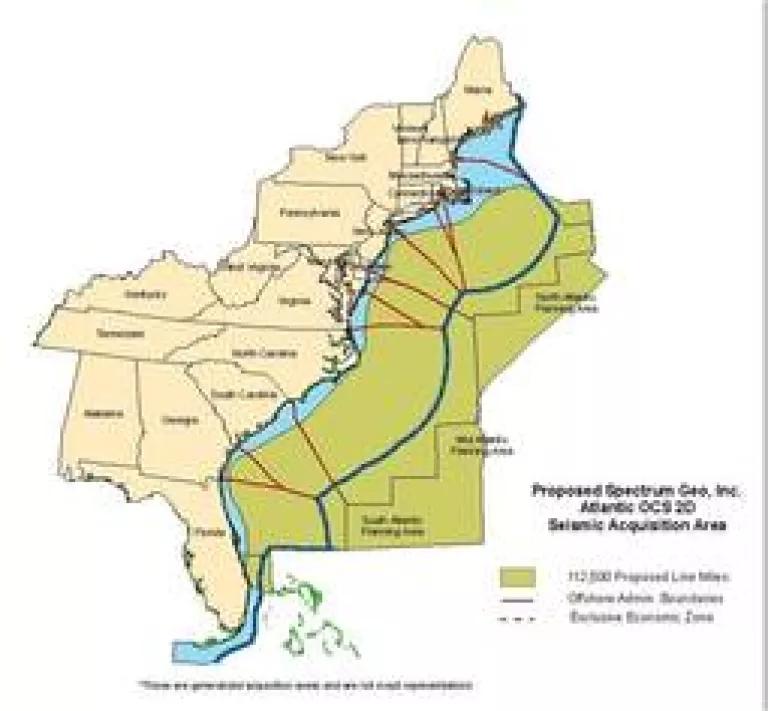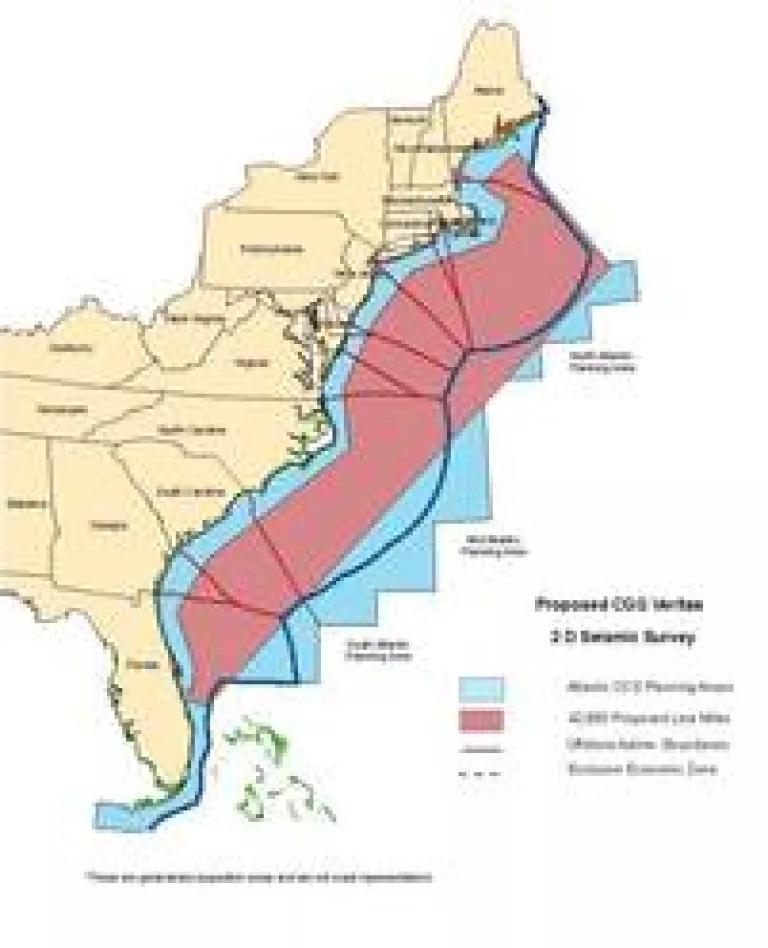
Imagine dynamite going off in your neighborhood every 10 seconds for days, weeks and months on end. Now imagine that you depend on your hearing to feed, mate, communicate and do just about everything else necessary for survival.
That’s the situation that endangered whales, commercial fish, and other marine wildlife are facing after the Obama Administration announced two weeks ago that it is opening up the mid- and south Atlantic to high-intensity seismic exploration for oil and gas for the first time in 30 years. The public will have a chance to weigh in this month – nearly two years to the day from the start of the BP oil disaster in the Gulf of Mexico – when the administration kicks off a series of hearings along the East Coast (April 16-27).
What you can do
Now is your chance to oppose this assault on our oceans. Please consider attending your local hearing -- see a schedule here. If you go, you’ll have the opportunity to speak against the proposal, or just support those who do. You can speak about its impacts on wildlife and fisheries (described below) or about how you feel about your state becoming the next stop on the “Drill, Baby, Drill” roadshow.
Or send an email to ggeis@boem.gov saying you oppose seismic exploration and offshore drilling along the East Coast.
Seismic exploration is not only a gateway drug to offshore drilling but – as the scientific community has recognized – it is a major assault on our oceans in itself, with harmful impacts not only to ocean wildlife, but coastal economies as well.
An industry ship towing an array of seismic airguns. Credit: Petroleum Geo-Services.
To prospect for oil and gas, the industry tows arrays of high-volume airguns behind ships, firing intense impulses of compressed air – almost as loud as explosives – every 10-12 seconds, 24 hours per day, for weeks and months. Industry has already applied to criss-cross the entire region with seismic ships, logging hundreds of thousands of miles from the New Jersey/ Delaware border to Florida, blasting all the way. Because of the enormous distance sound can travel in the ocean, the dangerous noise from this activity cannot remotely be confined to the waters off individual states that encourage it. Some impacts would stretch many hundreds of miles, affecting states as far north as New England.airgun and echosounders - board presentation 2005.wavwe were to fully develop all of our recoverable offshore oil reserves everywhere off the U.S., it would only lower pump prices by exactly 3 cents – and it would take 20 years to do so, according to the U.S. Energy Information Agency, an independent division within the Department of Energy.
Offshore oil is a snake oil cure. Green-lighting seismic in the Atlantic is just one of many ways the government has been coddling Big Oil and supporting its monopoly on our fuel supply. The government must not be allowed to sacrifice wildlife and the environment for this false promise.
There are greener, less harmful technologies on the horizon that can be used in place of airgun blasting. And if we’ve learned anything from the devastating and ongoing impacts of the BP disaster – from destroyed ecosystems and communities, to devastating job losses in the fishing, tourism, and recreation industries – it’s that the risks of drilling off the East Coast are too great for the Obama administration to take this to the next level.
Threat to marine mammals
Over the next eight years – according to the administration’s own estimates – seismic exploration would injure up to 138,500 marine mammals and disrupt marine mammal feeding, calving, breeding, and other vital activities more than 13.5 million times.
The intense pounding of industry airguns is loud enough to mask whale calls over literally thousands of miles, destroying their capacity to communicate and breed. It can drive whales to abandon their habitat and cease foraging, again over vast areas of ocean. Closer in, it can cause hearing loss, injury and death. Noise travels five times faster and many times farther in the ocean than it does in air, which is why whales, dolphins, and many other species depend on their hearing for reproduction and survival.

Right whale mom and newborn calf off Florida. Credit: NOAA.
The latest science from the National Oceanic and Atmospheric Association and Cornell University shows that endangered North Atlantic right whales – which calve off the coast of Georgia and Florida – are especially vulnerable. Given the scale, surveys off the coast of Virginia could affect endangered species off Southern New England down through the Carolinas, disrupting the right whale’s entire migratory range.
You can see a single airgun — just one of dozens found on large seismic arrays — firing underwater here:
And listen to what just one airgun sounds like underwater.
(More about the impacts of seismic exploration to marine mammals.)
Threat to lucrative fishing and tourism industries, jobs
Whales aren’t the only concern. For years, fishermen in other parts of the world have complained about loss of catch when seismic comes around – and for good reason. Airgun noise impacts at least 20 commercially available species of fish, including snapper, cod, haddock, herring, and various species of rockfish, as well as squid. Impacts range from habitat abandonment to reduced reproductive performance, and the result is fewer fish to catch.
For example, Norwegian researchers have shown that airguns displace commercial species of fish horizontally and vertically in the water column on a vast scale – over thousands of square kilometers. The result has been to dramatically depress catch rates of species such as cod, haddock, and rockfish, leading fishermen in Norway and other parts of the world to seek industry compensation for their losses. Catch rates have fallen around single arrays by as much as 40 to 80% over areas the size of Rhode Island, and persisted for days after surveys ended.
This, of course, could have serious negative impacts on commercial and recreational fishermen. In the regions proposed for airgun surveys, our fisheries support a total of 180,000 jobs, more than $7 billion in recreational fishing sales, and $380 million in commercial fishing revenue. In the northeast (New Jersey to Maine), parts of which could easily be impacted by seismic noise traveling beyond state lines, commercial and recreational fisheries support an additional 224,000 jobs, nearly $3.9 billion in recreational fishing sales, and $1 billion in commercial fishing revenue. Why should our Atlantic fisheries take this hit for the sake of Big Oil?


Two of the nine industry proposals that BOEM has already received to blast seismic off the Atlantic. Source: BOEM.
In addition to the negative economic impacts to coastal fishing industries, seismic poses threats to the $20 million whale-watching industry in the mid- and southeast Atlantic. And if the administration takes the next step and opens up the coast to oil and gas drilling, our entire $22 billion coastal tourism and recreational industry in the area proposed for seismic are at risk – and parts of the North Atlantic, too, where tourism and recreation provide an additional $24 billion.
Greener alternatives – and poor decisionmaking
According to two expert reports, including one funded by the oil and gas industry itself, greener alternative technologies that could substantially cut the environmental footprint of airguns in many areas are already well into development and could be available for commercial use in three to five years or less. Yet the administration is opening the floodgates now, in areas it doesn’t even intend to consider for leasing until 2017, if ever. And – incredibly – it’s allowing companies to reshoot the same areas again and again, needlessly adding to the impact on wildlife and fisheries in deference to a wealthy industry’s profit-squeezing business model.
Ultimately, if we have learned anything from the Gulf of Mexico disaster, it’s that the impacts of an oil spill are devastating and long term – for the environment, for wildlife, for communities, and for economies. Make no mistake: seismic brings its own form of ruin, and when seismic comes, pressure for drilling will follow. We must not open up the east coast of America to booming and drilling, risking our treasured coastline and wildlife, as well as multi-billion dollar fishing, tourism, and recreational industries that support hundreds of thousands of American jobs.